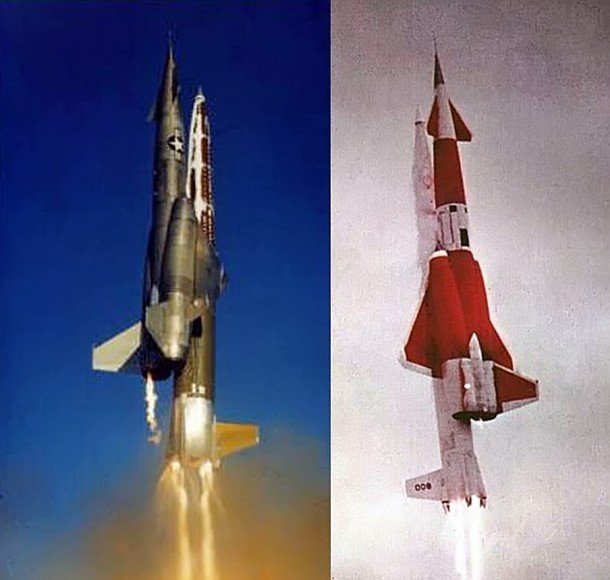
Fifty-seven years ago this month, a XSM-64 Navaho G-26 flight test vehicle flew 1,075 miles in 40 minutes at a sustained speed of Mach 2.8. It was the 8th flight test of the ill-fated Navaho Program.
The post-World War II era saw the development of a myriad of missile weapons systems. Perhaps the most influential and enigmatic of these systems was the Navaho missile.
Navaho was intended as a supersonic, nuclear-capable, strategic weapon system. It consisted of two (2) stages. The first stage was rocket-powered while the second stage utilized ramjet propulsion. The aircraft-like second stage was configured with a high lift-to-drag airframe in order to achieve strategic reach.
While there were a number of antecedents dating back to 1946, the Navaho Program really began in 1950 as Weapon System 104A. The requirements included a range of 5,500 miles, a minimum cruise speed of Mach 3 and a minimum cruise altitude of 60,000 feet. The payload included an ordnance load of 7,000 pounds delivered within a CEP of 1,500 feet.
North American Aviation (NAA) proposed a 3-phase development plan for WS-104A. Phase 1 involved testing of the missile alone (the X-10) up to Mach 2. Phase 2 covered the testing of the two-stage launch vehicle (the G-26) up to Mach 2.75 and a range of 1,500 miles. Phase 3 would be the ultimate near-production vehicle (the G-38). Only Phase 1 and Phase 2 testing took place.
The Navaho missile-booster vehicle measured 84 feet in length and weighed about 135,000 pounds at lift-off. The launch weight for the booster was 75,000 pounds; most of which was due to the alcohol and LOX propellants. The missile empty weight was 24,000 pounds.
On Friday, 10 January 1958, Navaho G-26 No. 9 (54-3098) lifted-off from LC-9 at Cape Canaveral, Florida. Climbing out under 240,000 pounds of thrust from its dual Rocketdyne XLR71-NA-1 rocket motors, missile-booster separation occurred at Mach 3.15 and 73,000 feet. Following air-start and take-over of twin Wright XRJ47-W-5 ramjets, generating a combined thrust of 16,000 pounds, the Navaho missile initiated a near triple-sonic cruise toward the Puerto Rico target area.
As the Navaho missile approached the environs of Puerto Rico, the vehicle was commanded to initiate a sweeping right-hand turn back towards the Cape. Unfortunately, the right intake experienced an unstart and a concomitant, asymmetric loss of thrust. Underpowered and without a restart capability, the vehicle was subsequently commanded to execute a dive into the Atlantic.
Flight No. 8, although only partially successful, flew longer and farther than any Navaho flight test vehicle. Only G-26 Flight No. 6 flew faster (Mach 3.5).
Although three (3) flights would follow G-26 Flight No. 8, all would suffer failure of one kind or another. In point of fact, the Navaho Program had been canceled on Saturday, 13 July 1957. The final six (6) Navaho flights were simply an attempt to extract the most from the remaining missile-booster rounds. Over 15,000 NAA employees lost their jobs the day Navaho died.
Navaho was cancelled primarily due to the ascendancy of the Intercontinental Ballistic Missile (ICBM). Very simply, an ICBM could deliver nuclear ordnance farther, faster and more accurately than a winged, unstealthy strategic missile. Navaho’s relatively numerous technical issues and programmatic delays simply served to drive the final nail into a long-prepared coffin.
While few today remember or even know of the Navaho Program, its technology has had a profound influence on all manner of aerospace vehicles up to the present day. Interestingly, the Space Shuttle launch vehicle concept bears a strong resemblance to the Navaho missile-booster combination. That is, a winged flight vehicle mounted asymmetrically on a longer boost vehicle.
